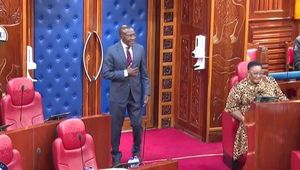As the Supreme Court prepares for its fall 2025 term, the nation stands on the cusp of potentially seismic changes in American law and governance. The justices, led by Chief Justice John Roberts, are set to reconsider a slate of high-profile precedents—some dating back nearly a century—touching everything from presidential power and campaign finance to religious expression and the rights of minority voters. With a 6-3 conservative majority unafraid to overturn established rulings, observers on both sides of the political spectrum are bracing for a term that could reshape the legal landscape for years to come.
One of the most closely watched battles centers on the president’s authority to remove leaders of independent federal agencies. The precedent in question, Humphrey’s Executor v. United States (1935), has long protected agency heads from being fired by the president for purely political reasons. But as reported by USA Today, recent emergency orders from the court have already allowed President Donald Trump to dismiss officials appointed by his predecessor, Joe Biden, signaling that the days of Humphrey’s Executor may be numbered. Georgetown law professor Victoria Nourse told USA Today that “Humphrey’s Executor is next on the Supreme Court’s chopping block, meaning the next case they are slated to reverse.”
This shift comes amid Trump’s broader efforts to consolidate executive power. The move has not gone unchallenged: Justice Elena Kagan, writing last month, warned, “For 90 years, Humphrey’s Executor v. United States has stood as a precedent of this court. Our emergency docket, while fit for some things, should not be used to overrule or revise existing law.” The outcome of this fight could redefine the balance between Congress and the White House, with ramifications for the independence of agencies like the National Labor Relations Board and the Consumer Product Safety Commission.
Campaign finance is also on the docket, with the court set to hear a challenge to a 2001 precedent—FEC v. Colorado Republican Federal Campaign Committee—that limits how much political parties can spend in coordination with federal candidates. According to USA Today, Democrats fear that overturning this ruling could “blow open the cap on the amount of money that donors can funnel to candidates.” The original lawsuit, filed by then-Senate candidate JD Vance and other Republicans, calls the 2001 decision an “aberration” and urges the court to overrule it as “plainly wrong the day it was decided.”
Republicans, for their part, argue that the caps are inconsistent with the Supreme Court’s modern campaign finance doctrine and have “harmed our political system by leading donors to send their funds elsewhere,” such as super PACs. The Roberts court has generally favored the view that campaign finance restrictions run afoul of the First Amendment, and a decision to strike down the 2001 precedent could further reshape the role of money in American politics.
On the social front, the Supreme Court is weighing whether to revisit its landmark 2015 decision in Obergefell v. Hodges, which legalized same-sex marriage nationwide. The appeal comes from Kim Davis, a former Kentucky county clerk who refused to issue marriage licenses to same-sex couples and was subsequently hit with a $100,000 jury verdict and $260,000 in attorney’s fees. Davis, framing her appeal in religious terms, argues that Obergefell was a “mistake” that “must be corrected.” In her filing to the court, Davis wrote, “If ever there was a case of exceptional importance, the first individual in the Republic’s history who was jailed for following her religious convictions regarding the historic definition of marriage, this should be it.”
Despite Davis’s fervor, most court watchers—including George Mason University law professor Ilya Somin—believe her case is an unlikely vehicle for overturning Obergefell. Somin noted, “They are not exercising their own rights, but the powers of the state,” referencing the distinction between public employees and private citizens in First Amendment cases. Still, the case has reignited debate over religious liberty and LGBTQ rights, signaling that the court’s willingness to revisit recent precedents remains an open question.
Another case with potentially far-reaching consequences involves Louisiana’s congressional district map. The court will decide whether the state violated the 14th Amendment by drawing only one majority-Black district out of six, despite a federal court’s earlier finding that this diluted Black voting power in violation of the Voting Rights Act. When state lawmakers attempted to remedy this by creating a second majority-minority district, a group of White voters sued, claiming the new district was drawn predominantly based on race and thus unconstitutional.
The Supreme Court’s handling of this case could gut a key provision of the Voting Rights Act. As USA Today notes, if the court rules that lawmakers cannot fix violations of the Act by drawing new majority-minority districts, it could make enforcing the 1965 law nearly impossible in the context of redistricting. Michael Li, senior counsel at the Brennan Center’s Democracy Program, told USA Today, “Some opponents of the Voting Rights Act may urge the court to go further and overturn long-standing precedents, but there’s absolutely no reason to go there.” The court’s decision will have nationwide implications for minority representation and the future of American democracy.
The justices will also revisit the so-called Feres Doctrine, a 1950 Supreme Court decision that bars service members and their families from suing the government for injuries “incident to service.” The case before the court involves the family of Air Force Staff Sgt. Cameron Beck, who was killed in a traffic accident on base. Critics, including Justice Clarence Thomas, have long argued that the doctrine is unjust. Thomas wrote earlier this year, “This court should overrule Feres. It has been almost universally condemned by judges and scholars.” Despite bipartisan criticism, the Justice Department maintains that “Feres has been the law for more than 70 years, and has been repeatedly reaffirmed by this court.”
Religious liberty and the separation of church and state will also be tested. The court is being asked to overturn a 2000 decision—Santa Fe Independent School District v. Doe—that barred student-led prayer over the loudspeaker at public school football games. A Christian school in Florida, forbidden from broadcasting a pregame prayer, is urging the court to rule that the earlier decision is “out of step with its more recent government-speech precedent.” The school’s attorneys argue, “Santa Fe was dubious from the outset.” The case follows the 2022 reinstatement of a high school football coach who lost his job for praying on the field, with Justice Neil Gorsuch writing that the prayers were “a brief, quiet, personal religious observance.”
These cases come as the Roberts court faces mounting scrutiny for its willingness to overturn precedent. According to Lee Epstein, a law professor at Washington University in St. Louis, the court has overruled precedent an average of 1.5 times per term since Roberts became chief justice, compared to 2.9 times per term prior to his tenure. Yet, the court’s recent decisions on abortion, affirmative action, and government regulation have already left an indelible mark on American law—and public trust in the institution has yet to recover from the 2022 decision overturning Roe v. Wade.
With arguments scheduled to begin in October 2025, the coming term promises to be a pivotal chapter in the ongoing struggle over the meaning of the Constitution, the reach of presidential power, and the rights of individuals and minorities. The nation, as ever, will be watching closely as the justices deliberate—and decide.




